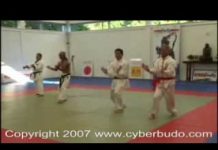There are many factors that officials look for when judging kata. Following are 10 tips from Christine Bannon-Rodrigues that should help you excel at Kata the next time you step in the ring. Basics Regardless of you rank, your basics need to be sharp. As a beginner, your basics might consist of a front kick and some simple punches. As an advanced competitor, your basics might include spinning kicks, jumping kicks or multiple hand combinations.
Stances
Stances are like the foundation of house. If they’re weak, you’ll have weak foundation or a poorly built house. If they’re strong, you’ll have a strong foundation or a strong, sturdy home. Keep your stances as low as they should be. Be sure that your weight distribution and foot alignment are accurate. Your posture is also very important before and after your presentation.
Power
A kata is a self-defense scenario against imaginary opponents. Therefore, your movements better be effective. Strong kicks, punches and blocks are essential. It’s better to have a strong low kick rather than a weak high kick. Don’t give up power for flash.
Balance
Stumbling during a kata routine is a major error. Don’t think it’s impossible to lose your balance, especially if you’re throwing advanced techniques. Therefore, demonstrate good balance and show that you are in control during the entire routine.
Speed
Some basic, traditional kata do not require much speed from strike to strike. However, even in a simple kata, show great speed in a single kick or a single punch. In the more advanced kata, showing a quick combination of movements is important. Try not to make your entire routine a blur, though. Stop for a couple of seconds after each combo to let the judges appreciate your solid stances, incredible balance and perfect basics. Don’t emphasize speed exclusively.
Intensity and Presence
Remember, when you are performing a kata, you are fighting imaginary opponents. Therefore, you should not have a blank look on your face or a smile. Be intense. Use your facial expressions to let the judges visualize what you are really doing. Be vocal and use your internal chi (energy) to deliver more power through your kiai (spirit yell).
Focus and Concentration
You must focus if you want your techniques to be accurate. Usually, when a person’s eyes start to wander, he is unsure of his next move. Don’t lose your concentration, whether you didn’t practice enough or because someone starts playing loud music in the ring next to you.
Flexibility
If your flexibility is good, you will be able to perform harder, fancier kicks or gymnastic moves. I don’t think there is anything more exciting than watching someone throw a kick straight up with good execution and power. If you’re a traditionalist, good flexibility will allow you to move with greater ease.
Difficulty of Movements
The more difficult your moves are, the higher you’ll score. However, many people put difficult moves in their routines before they are ready to throw them flawlessly. Wait until you can nail them every time.
Have a Good Backup
Make sure you know the rules regarding ties. Some tournaments may require a different routine. Even if they don’t require a different kata, have a solid backup. If you can go out and do a different kata just as well as the first, you are showing how multi-dimensional you are.
About the author: Christine Bannon-Rodrigues, was a member of Team Paul Mitchell, and won 135 grand championships during her career.




